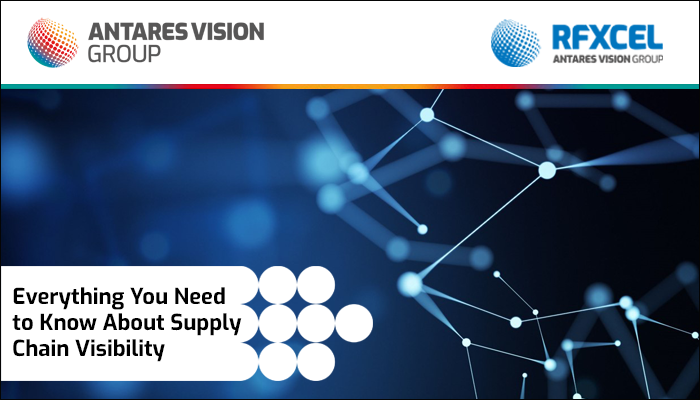The ability to monitor each part of your supply chain helps your business mitigate risk, serve customers better, and work more efficiently. Find out more about the importance of supply chain visibility in this guide from Antares Vision Group and rfxcel.
Understanding Supply Chain Visibility
Modern business operations require a high level of coordination and logistics. A company may source raw materials from one location, have a manufacturing facility in another location, and deliver products to customers all over the world. To produce, package, and ship goods efficiently, they need a centralized tracking system.
Supply chain visibility traces a product from its raw materials and through the manufacturing process to the point at which it reaches a customer’s doorstep. A visibility solution allows a business to track all its goods through every step in the supply chain. Supply chain visibility can:
- Increase efficiency
- Ensure customer satisfaction
- Inform decision-making
- Improve sustainability
Ultimately, visibility – or lack thereof – affects your bottom line.
Benefits of Supply Chain Visibility
To stay competitive in today’s globalized economy, businesses need efficient systems for monitoring supply and demand. Supply chain visibility benefits include:
- Tracking: Real-time tracking and traceability tools streamline inventory management, offering automation for many routine tasks.
- Efficiency: Visibility tools enhance the accuracy of demand forecasting and reduce the likelihood of stockouts.
- Risk management: Full visibility means that teams can respond more quickly when there is a supply chain disruption, mitigating the risk and minimizing delays.
- Optimization and better collaboration: Supply chain management systems help companies communicate better with suppliers, optimizing relationships and fostering collaboration.
Key Components of Supply Chain Visibility
Although supply chain visibility systems may differ from company to company, they all focus on transparency at each node of the supply chain. This includes:
- Inventory visibility: Companies can track and manage inventory levels and procurement across all their locations.
- Transportation visibility: All products in transit can be tracked and monitored in real time.
- Demand visibility: Robust supply chain network data allows businesses to understand customer patterns and forecast demand more accurately.
- Supplier visibility: Real-time visibility tools allow you to monitor supplier performance and ensure timely deliveries.
- Data visibility: By collecting information about inventory, transportation times, and more, companies can turn data analytics into actionable insights and adjust workflows or supply chain processes.
Implementing Supply Chain Visibility
Putting supply chain visibility tools into place takes time and effort, but it’s well worth the benefits you’ll reap in operational efficiency and better business performance. To implement supply chain visibility, start by assessing your current systems. Look for areas of improvement across the supply chain – have you experienced stockouts in a particular product line? Do you struggle to meet customer demand at a certain time of year?
Next, look for the right technology solutions that can enhance visibility across your entire ecosystem. Perhaps you have a good system in place for monitoring customer orders but need a better way to manage suppliers. Look for supply chain software that can integrate with your existing systems and address gaps in visibility.
You need a seamless flow of information across your technology platforms. Additionally, prioritize data security in any supply chain visibility initiative. Compliance with data privacy regulations is a must for your company, as well as any suppliers, shippers, or distributors you work with.
Best Practices for Supply Chain Visibility
Whether you work in pharmaceuticals or food and beverage, certain practices will improve visibility across the entire supply chain. These include:
- Metrics: Have a clear set of goals and metrics in place that you will use to measure your success.
- Collaboration: Build strong partnerships with suppliers to enhance transparency and efficiency.
- Technology: Invest in cloud-based platforms and advanced analytics tools with built-in supply chain security.
Above all, adopt a proactive approach to risk management and contingency planning. While some supply chain disruptions are out of your control, having a plan in place will make it easier to minimize inefficiencies and shortages.
Overcoming Challenges in Supply Chain Visibility
Even with the best-laid plans, you may face roadblocks when trying to improve end-to-end supply chain visibility. Potential challenges include:
- Supply chain data quality issues and data silos
- Resistance to change and organizational barriers
- Regulatory compliance and data privacy concerns
Managing a significant volume of data, especially when you are working in the context of a complex global supply chain with multiple partners and stakeholders, can feel overwhelming. That’s why it’s so important to find supply chain visibility software that integrates with all your data collection systems. You should look for a software service provider that is well-versed in regulatory compliance and has built-in data protections.
Understand that even when you choose an intuitive, user-friendly system, you’re likely to face pushback from some employees or partners. Plan a thoughtful implementation and roll-out process, with time built in for staff training. This will help address any concerns.
The Future of Supply Chain Visibility
Emerging technologies and digital transformation are changing the supply chain management landscape. Already, we’re seeing the value of artificial intelligence (AI) and machine learning in supply chain software solutions. AI-powered tools can analyze real-time data to inform forecasting, using predictive analytics to inform orders, pricing, warehouse placement, and more.
The Internet of Things (IoT) and blockchain technology are also shaping supply chain visibility. By giving all supply chain stakeholders access to the same information, blockchain tools can potentially reduce fraud and data errors while improving communication. And the proliferation of IoT devices means that real-time tracking is easier throughout order processing and delivery.
We’ll Help You Achieve Supply Chain Visibility
We offer supply chain visibility solutions that prioritize efficiency and compliance management. With offices in the United States and abroad, we serve clients in sectors including:
- Pharmaceuticals
- Food
- Beverage
- Consumer goods
- Government
For information on our supply chain visibility tools or to request pricing, contact us today.





